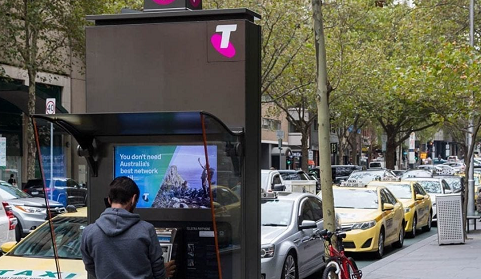Telstra payphones with large digital screens are not “low-impact facilities” and the company must obtain council planning permission to install them, the Federal Court has ruled.
The decision overturns a previous Federal Court ruling that allowed Telstra and its outdoor media company business partner, JCDecaux, to install large digital billboards as part of a roll-out of 1800 new payphones – provided Telstra sought local council approval to display third-party commercial advertising on the screens.
The Melbourne and Brisbane City councils appealed against the March ruling by Federal Court Justice David O’Callaghan that the new payphone cabinets were “low-impact facilities” when the 190cm LCD screens digital screens were used only to promote Telstra’s standard telephone service.
The two councils said the new cabinets were clearly designed to display advertising to maximum effect and were just a means for Telstra to bypass local planning regulations and generate advertising revenue.
After the City of Melbourne rejected Telstra’s application for approval to host commercial advertising on 81 proposed new payphone billboards in May last year, the carrier launched proceedings to clarify the meaning of low-impact facilities under the Telecommunications Act 1997.
Coincidentally, the City of Melbourne began proceedings in the Victorian Civil and Administrative Tribunal to have the booths redefined as not being low impact.
Last Friday, the court ruled in favour of the Melbourne and Brisbane city councils’ appeal, with Justices Michael O’Bryan and Jacqueline Gleeson saying the original judge had erred in labelling the proposed booths “low-impact” facilities.
Telstra had argued that the question of whether a facility is low-impact “is to be assessed at the time the facility was installed and not at a later time” – since it planned to switch on the new cabinets on installation and restrict the display of advertising for 28 days.
Having gained planning permission, Telstra planned to then display third-part commercial advertising.
Justice O’Bryan found this line of reasoning to be paradoxical.
“It is passing strange that Telstra has applied to the Melbourne City Council for planning permission to display commercial advertisements on its proposed new payphone cabinets while asserting that the new payphone cabinets are low-impact facilities which, relevantly, are required to be facilities that will not be used for commercial advertising,” he said in findings echoed by Justice Gleeson.
Justice O’Brien’s judgment added: “The whole of the evidence establishes that Telstra is seeking to install payphone cabinets that display commercial advertising.
“There is nothing in the evidence to suggest that Telstra would install the new payphone cabinets if it does not receive planning permission to display commercial advertising.”
Other capital city councils where Telstra and JCDecaux have begun installing the new payphone cabinets (including Adelaide, Sydney, and Perth) have also raised concerns about them contributing to footpath congestion and disrupting pedestrian traffic.
Telstra has been ordered to pay the two councils’ legal costs.



